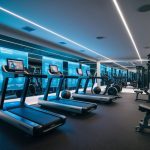
Creating a personalized fitness program tailored to individual goals is the first step toward achieving specific health and fitness objectives. Understanding one’s own fitness goals is crucial, as it guides the structure of the workout plan. Whether the aim is to lose weight, build muscle, or enhance overall health, a well-structured plan can provide the necessary framework to reach these targets.
Motivation plays a critical role in maintaining consistency and pushing through challenges in any fitness journey. Personalizing a fitness plan to include enjoyable activities ensures an increased likelihood of adherence. This not only boosts motivation but also makes the entire process more engaging and rewarding.
Tracking progress is essential for success. Keeping a record of workouts, nutrition, and changes in physical measurements can help identify what works and what needs adjustment. By analyzing this data, individuals can refine their approach, ensuring their efforts align closely with their desired fitness outcomes.
Setting the Foundation
Creating a personalized fitness program begins by establishing a strong foundation, ensuring clarity in one’s objectives and a realistic assessment of current physical capabilities. Tailored programs succeed when built upon well-defined goals and an honest evaluation of where one stands.
Define Your Goals
Establishing clear goals is essential. Individuals should articulate their aspirations, such as weight loss, muscle gain, or improved endurance. Employing the SMART criteria can enhance goal-setting by ensuring goals are Specific, Measurable, Achievable, Relevant, and Time-bound. For instance, choosing to lose 10 pounds in three months is more actionable than a vague desire to be healthier. Aligning goals with personal preferences and lifestyle is crucial. For example, someone who dislikes running might benefit more from swimming or cycling. Setting realistic goals helps maintain motivation and avoid burnout.
Assess Your Current Fitness Level
An honest evaluation of current fitness levels can direct the structure of a fitness program. This can include several components like cardiovascular endurance, muscular strength, flexibility, and body composition. Simple tests like measuring running distance over a set period or the number of push-ups can provide insight. Understanding one’s starting point helps to gauge progress accurately and adjust the program as needed. Consulting a professional for assessments could provide a more detailed baseline and identify areas to focus on. A realistic view of current capabilities ensures safety and effectiveness in a fitness routine.
Creating a Balanced Program
Creating a balanced fitness program involves integrating diverse exercises and ensuring steady progression. It’s crucial to cater to endurance, strength, and mobility for well-rounded results.
Incorporating Variety in Your Routine
Incorporating a mix of cardio, strength training, and flexibility exercises helps to address different fitness components. Cardio can include running, cycling, or swimming, which enhance cardiovascular health and endurance. Strength training, such as using free weights or resistance bands, improves muscle tone and strength. Flexibility exercises like yoga or Pilates increase range of motion and decrease injury risk.
A personalized workout is essential for meeting individual goals, so it’s important to choose the right exercises that align with one’s interests and capabilities. Regularly changing routines minimizes plateaus and maintains engagement, promoting consistent progress over time.
Planning for Progression
Progression is vital for continued improvement in any fitness program. To effectively plan for progression, increase the intensity or volume of workouts gradually. This might involve adding more weight, increasing repetitions, or reducing rest intervals in strength training routines. For cardio, adjusting the duration or intensity through interval training can enhance endurance and capacity over time.
Monitoring progress helps in recognizing when to adjust elements of a routine to continue challenging the body. This approach ensures ongoing development without risking injury or burnout. Regular assessments provide insights into how the body is adapting, making it possible to customize the program further to meet evolving fitness goals.



